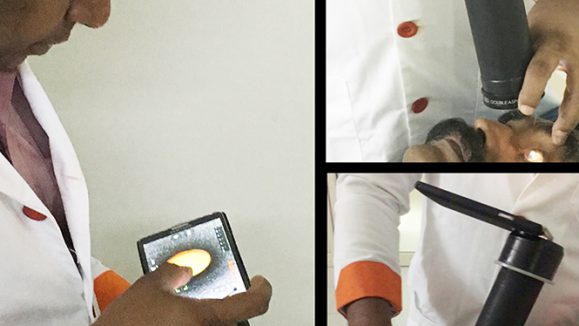The potential and use of artificial intelligence (AI) in ophthalmology is a topic that has become increasingly popular — so much so that it sometimes feels like the robots are taking over. Well, perhaps that’s somewhat exaggerated … but you get our point, AI is big and here to stay.
The question of which areas of ophthalmology are most likely to benefit from increased AI uptake is an interesting one, and we’re already getting more familiar with some of them. Patient screening is a good example, as AI is often able to complement other screening options like fundus and optical coherence tomography (OCT) imaging. AI’s application in the field of age-related macular degeneration (AMD) treatment is another exciting field to consider as AI could offer tangible benefits to patients and clinicians, alike.
According to the authors of Insights into the Growing Popularity of Artificial Intelligence in Ophthalmology, AI plays an important role in the early screening and detection of conditions such as diabetic retinopathy (DR), AMD, retinopathy of prematurity (ROP), and other diseases, like glaucoma. When it comes to AMD specifically, the study reports that AI-driven analysis of OCT for morphological variations in scanning and detecting intraretinal or subretinal fluid shows promise. Indeed, the researchers found that the accuracy of AI-assisted screening was generally higher than 90% when compared to diagnosis by retina specialists alone.1
AI: Beyond Diagnosis in nAMD
The study then considers what the future holds for AI in ophthalmology beyond diagnostic imaging. This includes research into the automated grading of cataracts; managing pediatric conditions, such as refractive errors; applications in ocular oncology, using multispectral imaging; and new algorithms to measure inner and outer retinal layer thicknesses to predict the risk for Alzheimer’s disease. AMD is another area experiencing increased development, and specifically in predictions for neovascular AMD.
The neovascular form of AMD, or wet AMD, is found in up to 20% of patients affected by the condition. It usually occurs after the patient has already contracted the atrophic or dry variety of the disease, and accounts for 90% of all cases involving severe vision loss. Neovascular AMD causes blood vessels under the retina to grow toward the macula, and as they are abnormal, they tend to break, bleed and leak fluid, damaging the macula and causing it to lift up and pull away from its base.2
This process is what causes severe vision losses in patients with neovascular AMD, so treatment into how AI can help improve patient outcomes is welcome. Artificial Intelligence Based Predictions in Neovascular Age-Related Macular Degeneration examines how developments in areas beyond image analysis could be utilized.
The researchers focused on the development of algorithms for predicting treatment response and treatment frequency needs in neovascular AMD patients. Using a dataset of patients at Moorfields Eye Hospital in London, one study applied AI deep learning to analyze the patient information contained therein. The AI algorithm was able to predict baseline visual acuity and OCT parameters for three months post-injection and 12 months post-baseline of R2 = 0.49 and 0.38, respectively, which improved to R2 = 0.79 and 0.63 by incorporating previous treatment response (incremental visual acuity and OCT changes).3
The researchers concluded that while some work remains, as few large datasets with high-quality spectral-domain OCT data were available for study, AI still holds considerable promise in neovascular AMD. If the benefits of AI become more apparent, it will hopefully lead to the creation and collection of more high-quality datasets to study.
References
- Dutt S, Sivaraman A, Savoy F, Rajalakshmi R. Insights into the Growing Popularity of Artificial Intelligence in Ophthalmology. Indian J Ophthalmol. 2020;68(7):1339-1346.
- The Difference Between Wet and Dry Age-Related Macular Degeneration. Vision Aware. Available at https://visionaware.org/your-eye-condition/age-related-macular-degeneration-amd/wet-and-dry-amd/. Accessed on Wednesday, January 26.
- Ferrara D, Newton EM, Lee AY. Artificial Intelligence Based Predictions in Neovascular Age-Related Macular Degeneration. Curr Opin Ophthalmol. 2021;32(5): 389–396.



